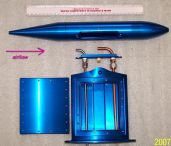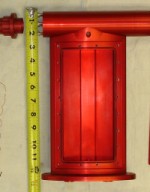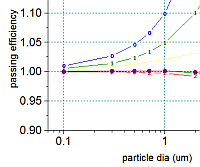| At typical research speeds for
HIAPER, there will be ~15
to 20°C dynamic heating of the air as it adjusts to the
aircraft speed. This heating can evaporate volatile components of
aerosols. It also helps prevent icing of the inlet
tip. There
is also active electrical resistance heating of the inlet tip to
prevent rime ice accumulation in supercooled water clouds.
The tip temperature is
regulated to
maintain +5°C. Electrical heating can be switched off
if desired.
Even with dynamic heating and a
heated tip, it is possible for supercooled water
to pass the tip, impact on the interior sampling tube and accumulate as
rime ice, because the inner tubes are not heated.
This problem may be
recognized by a reduction
in sample pressure. Monitoring of sampling pressure is therefore
suggested in
order to determine if this problem occurs.
There may be additional dynamic pressure inside the HIMIL,
depending on the orientation of internal sample tubes (pointing
uptream, downstream or orthogonal to the flow) and sample pumping rates
through those tubes.
|
|
inlet temperatures
during flight
 |










